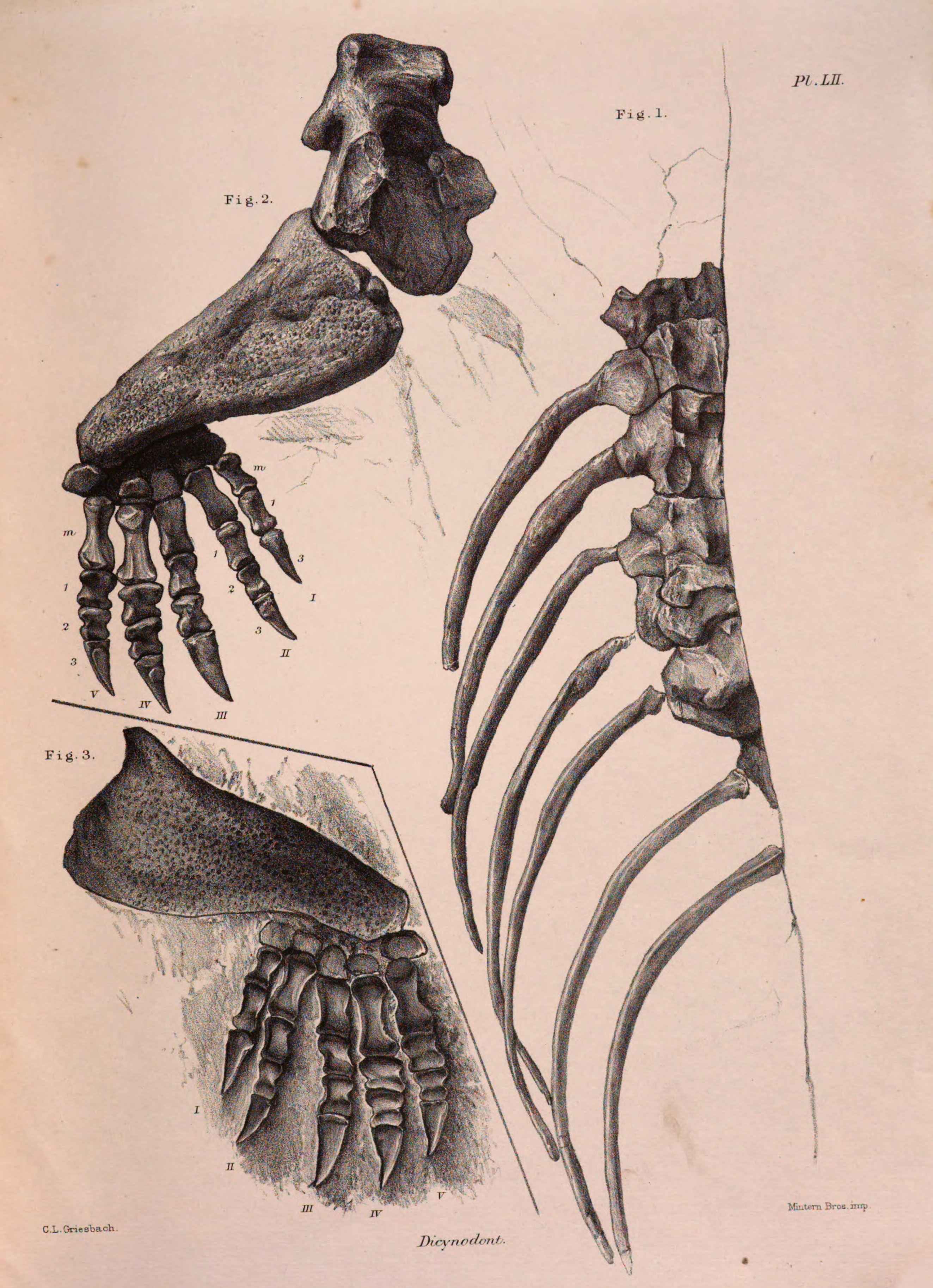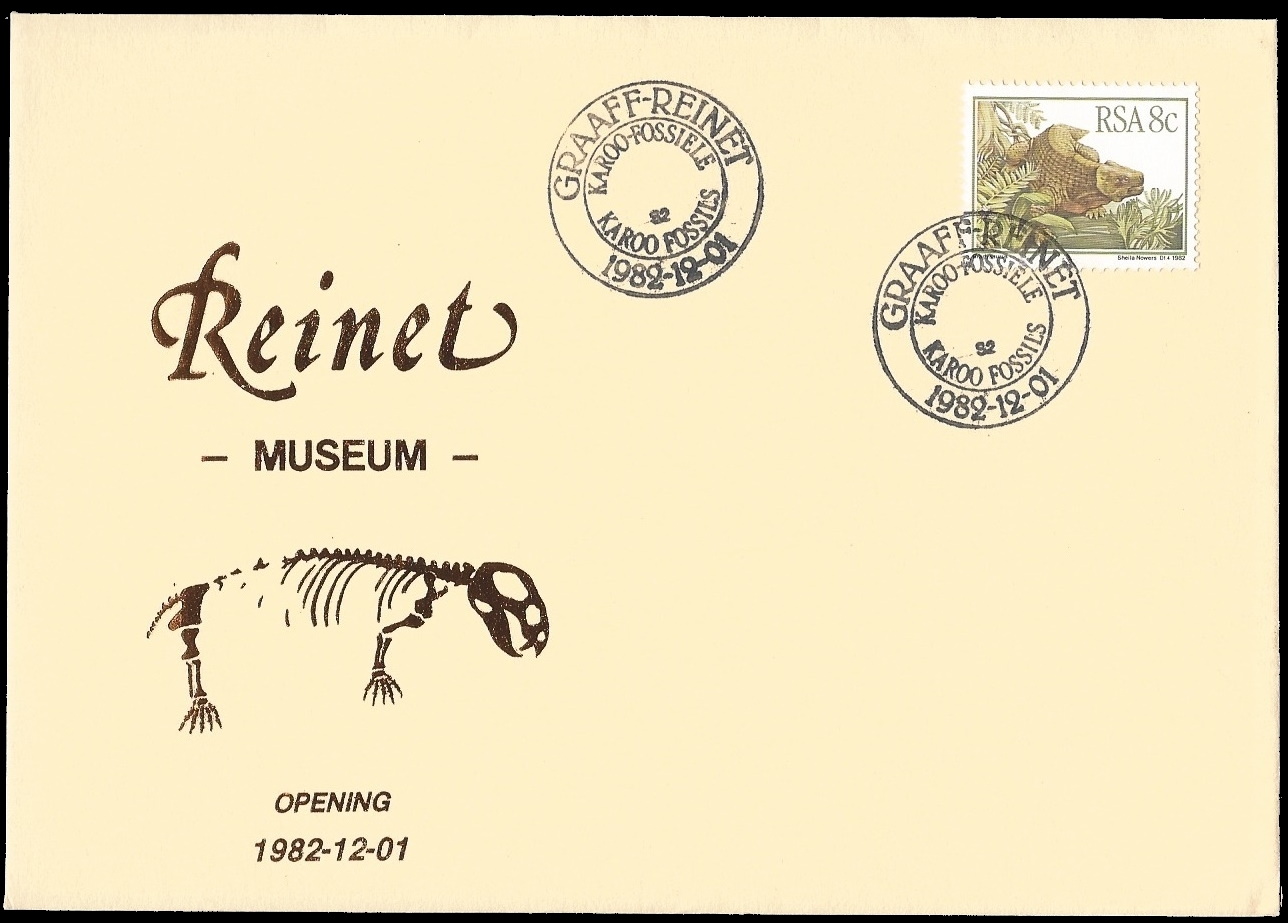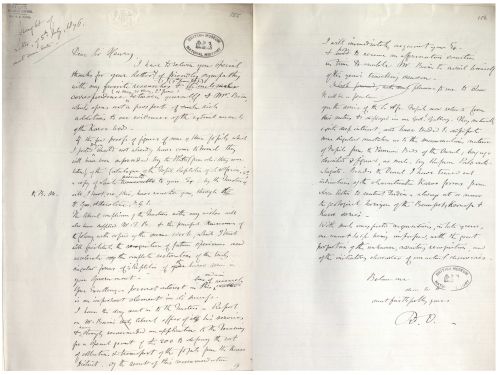the place where Paleontology and Paleoanthropology meets Philately
Letter from Richard Owen to Sir Henry Barkly, 1876
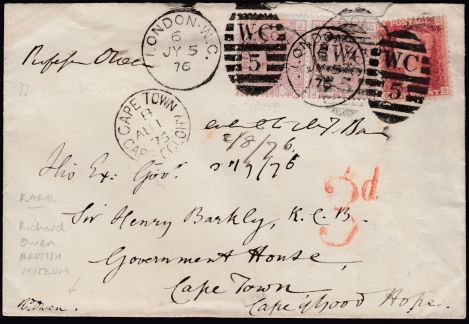 |
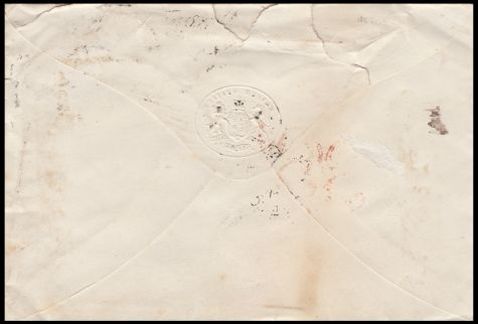 |
The letter sent by Professor Richard Owen (at the time, Richard Owen had not been knighted yet) from the British Museum to Sir Henry Barkly, the Governor of Cape Colony and British High Commissioner for Southern Africa, in Cape Town in 1876.
The letter sent from London on July 5th, arrived at Cape Town on August 1st 1876. The signature of Richard Owen is on the bottom-left corner of the cover.
Regarding the envelope
Owen's signature (R. Owen) is clearly seen on the bottom-left corner of the envelope. The embossed crest of the British Museum can be seen on the reverse side of the envelope.

|
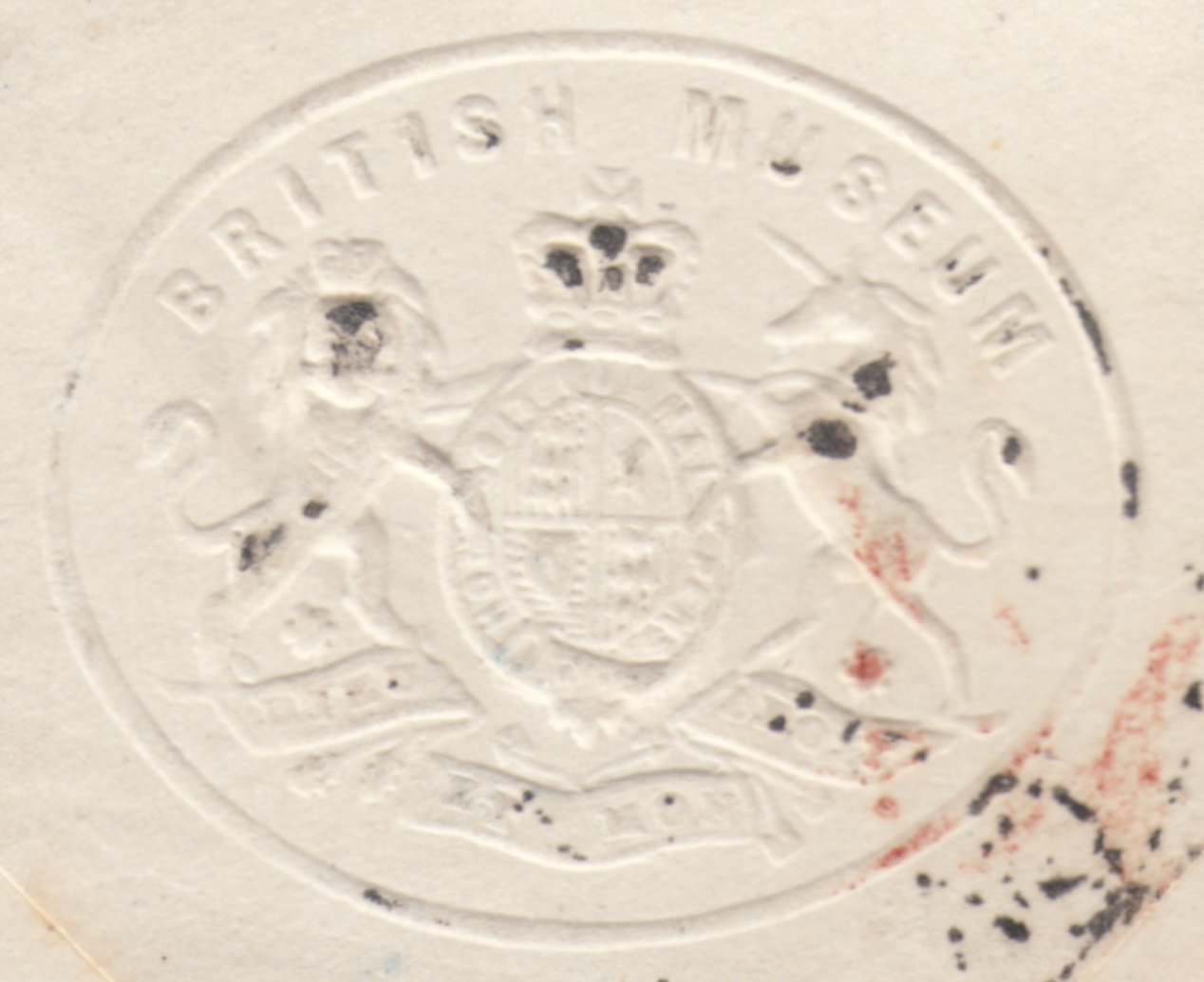 |
| Richard Owen's signature is clearly seen on the bottom-left corner of the envelope. | Embossed crest of the British Museum from the reverse side of the envelope |
" Professor Owen
His Ex. Gov.
Sir Henry Barkly, K.C.B,
Government House,
Cape Town,
Cape of Good Hope
Notes:
- His Ex. Gov. is an abbreviation for "His Excellency the Governor"
- K.C.B. stand for Knight Commander of the Order of the Bath
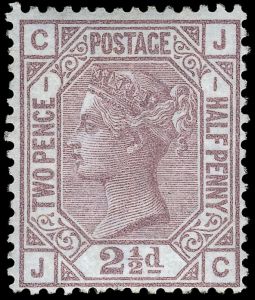 |
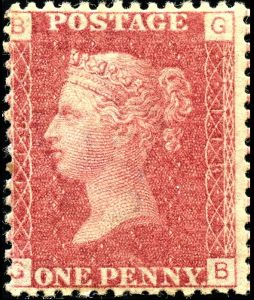 |
| The stamps from the top-right corner of the cover are: | |
| Queen Victoria - "Two pence and half penny" stamp, Great Britain 1875, MiNr.: 40, Scott: 66, SG: 138. |
Queen Victoria - "Penny red" stamp, Great Britain 1864,
MiNr.: 16, Scott: 33, SG: 43. |
The letters on the corners are the plate identification. The letters were engraved in all four corners of the stamp. The letters on the bottom corners were the same as on the top but in reverse order (BG/GB).
Two other stamps, are "Two pence and half penny", issued in 1875.
The plural of penny is pence when referring to an amount of money, but
pennies when referring to a number of coins.
Thus 6d is six pence, but "six pennies" means specifically six individual penny coins.
These stamps are cancelled by four duplex postmarks.
A duplex canceller was a hand stamp used to cancel postage stamp with obliterator (the oval shape)
and imprint a dated postmark applied simultaneously with the one device.
The main purpose of the obliterator was to clearly cancel the stamps so as to prevent any re-use.
The device had a steel die, generally circular, which printed the location of the cancel,
together with the time and date of cancel.
This die was held in place by a handle with an obliteration marker, often oval shaped,
off to the right side that was applied over the postage stamp to prevent its reuse.
Later on, postal authorities around the world started to use cancellations with slogans, images, or even simple
wavy lines.
These cancellations still prevent the re-use of stamps, but don't obscure their images.
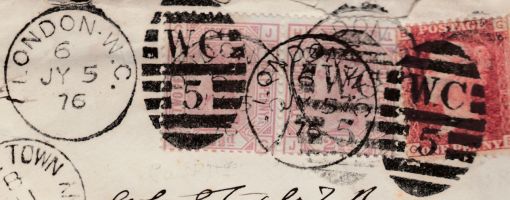
|
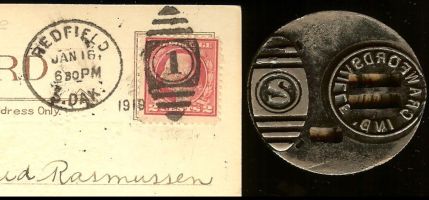
|
| Duplex cancellations over postage stamps of tbe envelope. | An example of the duxplex device |
The first two duplex postmarks with partial visible obliterator mark applied on the stamps. The first cancelled the left stamp, another one applied on the middle and the red penny stamp. The obliterator part is visible on the middle stamp and almost invisible over the red penny. The duplex was re-inked and two further, much clearer, strikes were applied.
The "Obliterator" or "stamp killer" is the oval mark with "WC" and number 5 below.
The WC (West Central) refers to a postal district in London. (In 1856 London was divided into ten Postal Districts. Later some districts were merged.) The British Museum is located in the WC district of London.
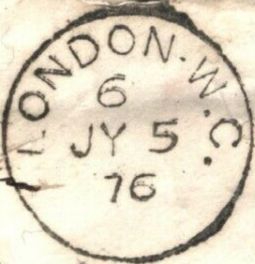 |
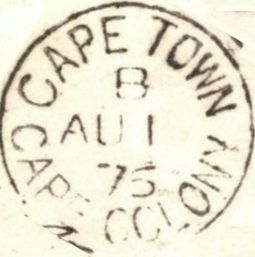 |
| Postmark of London | Postmark of Cape Town |
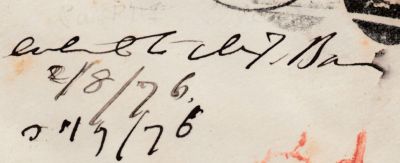 |
|
| The receipt and reply dates, written by Sir Henry Barkly | |
"LONDON W.C., 6, JY 5, 76".
This means, the letter was sent from London (Western Central), on July 5th 1876.
The 6 is the Date-Stamper's Code to distinguish (only in local GPO records) who exactly was using that specific obliterator for that specific duty.
(Postmarks with actual time codes, "6 pm" for example, were not generally introduced until much later in the Victorian era. In Great Britain that was only typical of the majority of date stamps from 1894 onwards.)
A postmark showing the receipt of the letter by the Cape Town Post Office is underneath:
"CAPE TOWN, B, AU 1, 76, CAPE COLONY".
This means, the letter was received on August 1st, 1876 in Cape Town.
The letter B is exactly the same as number 6 on the postmark of London.
The manually written dates under the stamps were probably written by Sir Henry Barkly. The first date, 2/8/76 is the letter receipt date. The second date, ?/9/76 is the date of the reply sent to Richard Owen from the British Museum.
A large 3d on the right side of the cover is an Accountancy Mark.
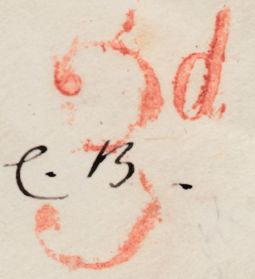 |
| Accountancy Mark of 3 pence |
On July 1st 1876, the rate of letters with weight not exceeding 1/2 oz (1 oz or 1 ounce is equal 28.35gr) to Cape of Good Hope was reduced from 1 Shilling (1s) to 6 Pence (6d). [1]
Financial inter-relationships between the Post Offices of various countries, as well as of the imperial centers and their colonies, were very complex in this period.About the sender, Sir Richard Owen and the recipient, Sir Henry Barkly of the cover.
Sir Richard Owen (20 July 1804 – 18 December 1892) was the leading comparative anatomist and palaeontologist of his time, a contemporary of Charles Darwin. A controversial figure, he is perhaps best known for coining the word dinosaur (meaning "Terrible Reptile" or "Fearfully Great Reptile") and for his outspoken opposition to Charles Darwin's theory of evolution by natural selection.
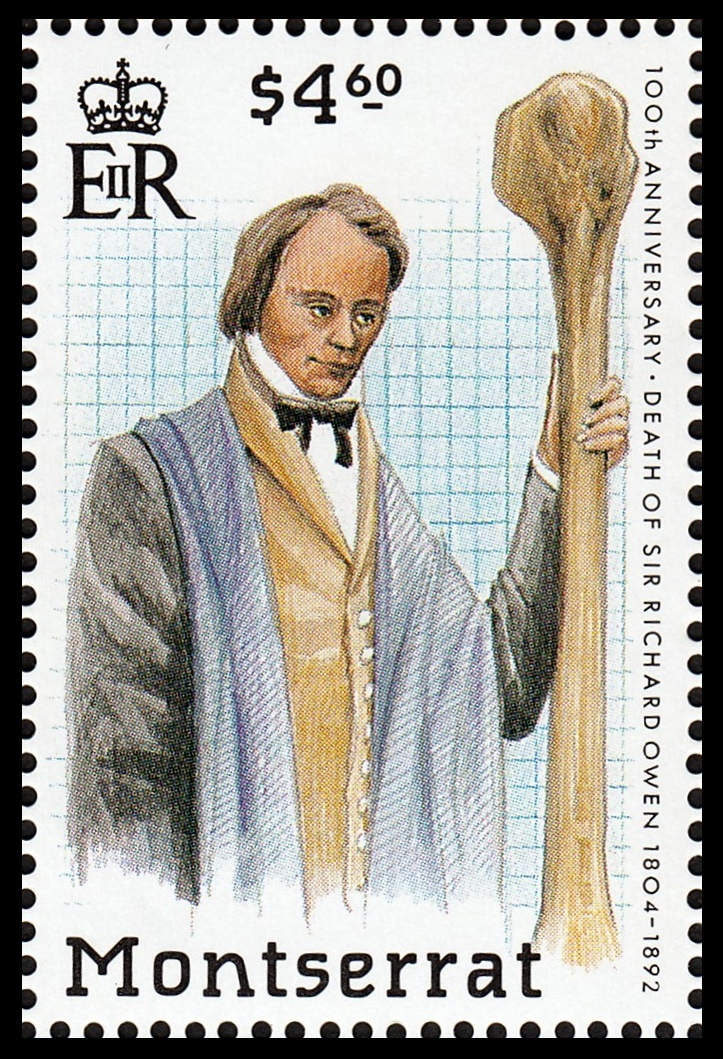
|
| Sir Richard Owen on stamp from Souvenir-Sheet of Montserrat 1992. MiNr.: 837 (Bl. 63), Scott: 794 |
He was the driving force behind the establishment, in 1881, of the British Museum (Natural History) in London.
In 1856, Owen became superintendent of the Natural History department of the British Museum. He then devoted much of his energies to a great scheme for a National Museum of Natural History, which eventually resulted in the removal of the natural history collections of the British Museum to a new building at South Kensington: the British Museum (Natural History), now the Natural History Museum.
There was an enduring partnership between Darwin and Owen, at least until 1859, when Charles Darwin published his most famous book "The Origin of Species".
Owen was indebted to Darwin for letting him describe the South American fossil mammals and for many other particulars of Natural History. Darwin sent many packages to Owen during his voyage on the HMS Beagle between 1831 and 1836, especially from South America.
In one of the letters to Owen, sent on 26th March, 1848, Charles Darwin wrote [R8]:
"When next I come to town ..., I must call on you, & report for my own satisfaction,
... you cannot tell how much I enjoyed my talk with you here.
Ever, my dear Owen | Yours sincerely | C. Darwin"
Owen’s greatest legacy is the Natural History Museum, but he was also an adviser to governments, reported on environmental health issues and was awarded more than 100 honours – including a knighthood in 1883.
Even though his friends included Charles Dickens, an advisor to Prime Minister William Gladstone, Owen was a contradictory character. His actions alienated many; others were jealous of the scale of his success.
Queen Victoria (shown on the stamps form the cover) granted Owen the prestigious Sheen Lodge in Lincoln Park as a residence in 1852 but lost all interest in the Natural History Museum after his retirement.
In 1991, Great Britain issued a set of five postage stamps "150th Anniversary of Dinosaurs' Identification by Sir Richard Owen".
The stamps show skeletons and silhouettes of five well known dinosaurs. Sir Richard Owen was depicted on the cachet of an official and several customized FDCs.
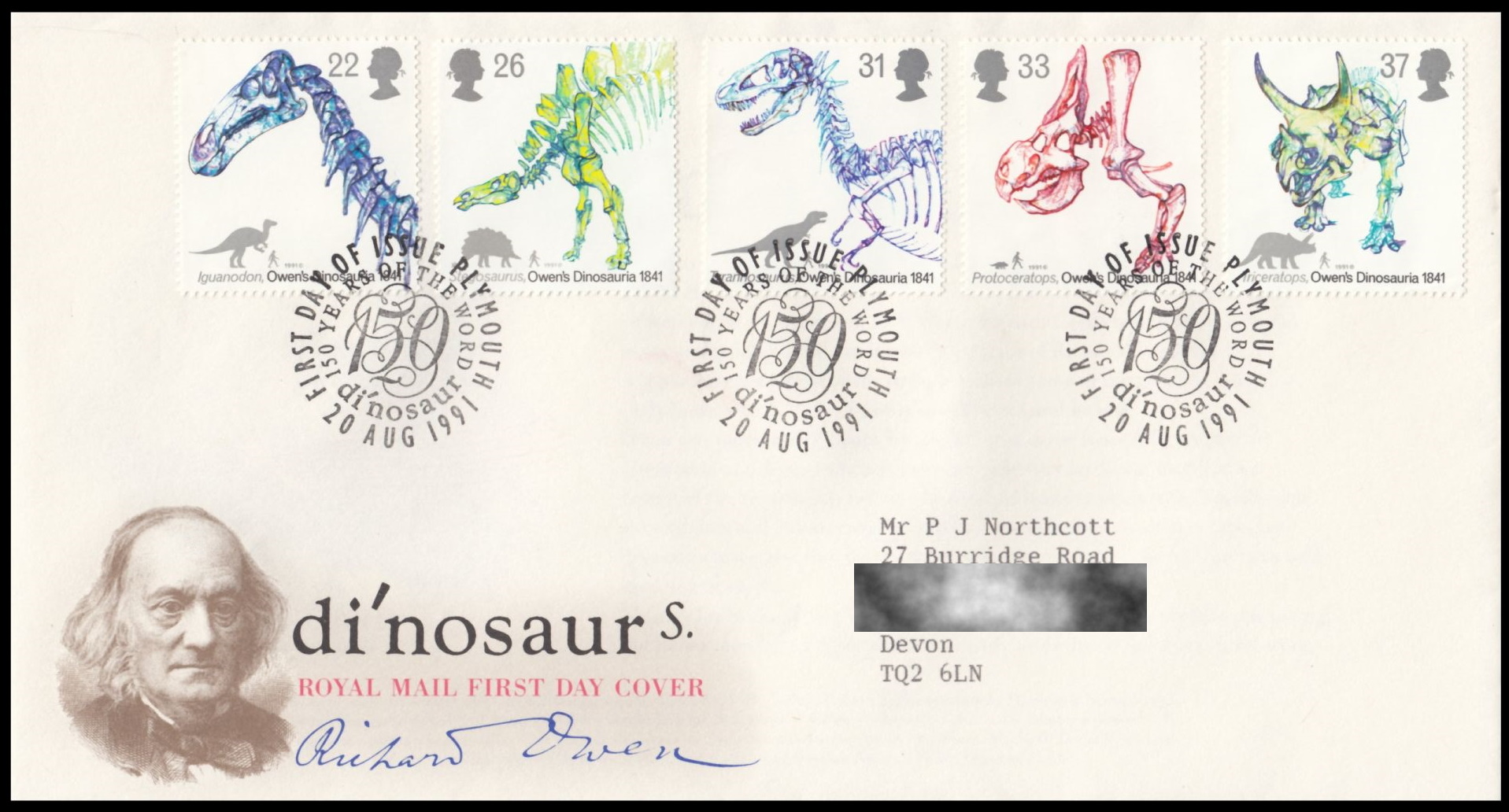
Unfortunately, the United Kingdom has yet to publish a stamp issue depicting Richard Owen. The only known stamps depicting Sir Richard Owen were issued by: Montserrat 1992, Sao Tome and Principe 2014, Togo 2015, the last two are considered "undesirable".
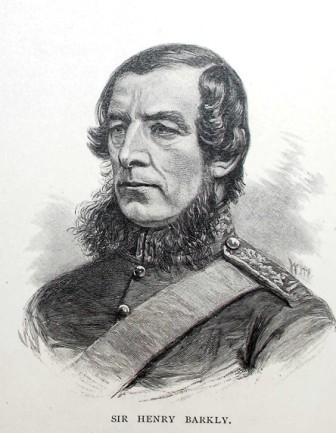 |
| Portrait of Sir Henry Barkly, 1886. Artist William Macleod, (1850-1929). Image credit Victorian Collection |
Henry Barkly (24 February 1815 – 20 October 1898) was a British politician, colonial governor, and patron of the sciences.
In November 1856, Barkly was appointed Governor of Victoria, Australia, arriving in Melbourne on 24 December 1856.
He achieved one of his main goals of stable government with the appointment of the James McCulloch ministry.
He was noted for his support of philanthropic and intellectual movements.
Sir Henry Barkly was a founder and president of the Royal Society of Victoria, 1860–63, and helped to found the National Gallery of Victoria,
the Acclimatization Society and the National Observatory.
From 26 November 1863 to 4 June 1870 Barkly was appointed 10th Governor of Mauritius .
In August 1870 he was sent to the Cape of Good Hope as Governor of Cape Colony and as British High Commissioner
for Southern Africa.
Henry Barkly helped to implement responsible government in the Cape and worked closely with John Molteno, its first elected Prime Minister.
He served in South Africa until 1877 and played an important role in assisting the early growth of the Cape Liberal tradition.
Henry Barkly had a lifelong interest in statistics and the in natural sciences.
He was willing to accept evolution in the plant and animal kingdom but expressed horror at the idea of mankind's simian origins.
Like many other leading figures of that time, Sir Barkly addressed evolution as an unproven if compelling hypothesis.
The Letter from the Envelope
On May 21st 1876, Thomas Bain, wrote to Sir Henry Barkly, the governor of Cape Colony, offering to put his experience at Owen's disposal in making a collection which would extend that made by Bain's father almost forty years earlier.
Thomas Charles John Bain (1830-1893), was a prolific road engineer.
He was one of three sons of Andrew Bain, accompanied his farther as a boy, on his trips to the
Karoo and helped his farther to search and dig for fossils.
He gets a passion for fossils digging and sent many of them to the British Museum in London.
Andrew Geddes Bain (1797-1864), father of Thomas Bain (A. Bain had 3 sons and 7 daughters),
was a South African geologist, borne in Scotland, road engineer, palaeontologist and explorer.
Since 1838 he sent many fossils to the British Museum in London.
Several fossil specimens were known on honour of him by Richard Owen.
In 1864, Andrew Bain was granted sick leave to visit England, where he was entertained by Professor
Richard Owen and Sir Roderick Murchison, who served as director-general of the British Geological Survey from 1855 until his death in 1871.
(Sir Roderick Impey Murchison (1792-1871), is noted for investigating and describing the Silurian, Devonian and Permian systems.)
In his letter, Thomas Bain wrote:
My dear Sir,
Having read with much interest an Article in the last Cape Monthly - extracted from the
'Proceeding of the London Geological Society' - on the subject of a discovery by Professor Owen
of species of Carnivorous reptiles amongst specimens of Karoo Saurians sent to the Society by my
Farther from time to time, it may not be out of place on my part to mention to you, for
the information of Professor Owen, that in my frequent rambles through the Karoo, I have placed
my marks on - I may say - scores of fine specimens which were unfortunately out of my power to dig
out & to carry along with me, as I generally travel with a light Cart, & am unprepared to
exhume such monsters as some of them are.
Some time ago you were good enough to send me for perusal a letter you had received
from Professor Owen on the receipt by him of a fossil arm or paddle I sent you from
Gray Reinet, & in that letter he mentioned that these was a very scanty collection of
South African Saurians in the British Museum, & seemed anxious that should be augmented .
If the Professor would authorise a small Outlay, I would undertake provided the
Government would grant me a couple of months leave of Absence - to go with a Bullock Wagon
to the Karoo to make a large collection for the Museum, out of which Professor Owen
may probably prosecute his discoveries still further.
The months of September & October are the best for Ox-wagon traveling in the
region where fossils are most abundant.
...
Believe me
My dear Sir,
Absolutely Yours,
Thomas Bain.
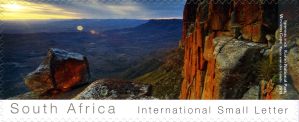 |
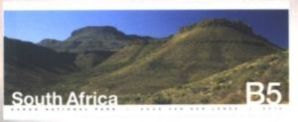 |
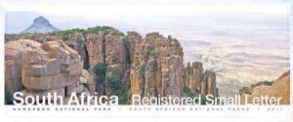 |
| Landscape of Karoo region on stamps of South Africa 2013, 2014 and 2017. MiNr.: 2229, 2340, 2495; Scott: 1497a, 1529b, ? . | ||
On June 6th 1876, after clarifying the cost of the expedition (Bain asked for £180 [3]), Sir Henry Barkly sent a letter to Richard Owen, professor of the British Museum, where he described Thomas Bain's proposal.
My dear Professor Owen
I have delayed thanking you for your letter
of 19th November last in the hope that I might be in
a position to forward to you the remainder of the
skeleton of the Dicynodon which Mr. Thomas Bain
promised me to get dug out.
That hope as you will see by a letter from him
which I enclose has proven vain. My object in
sending his communication, however is to bring to
your notice his offer to give the benefit of his
knowledge of the Karoo Region when these
Secondary fossils [4] are found in collecting a large
number of them, provided the expenses of this
trip could be paid. You will see from a second
communication, which I likewise forward, that he estimates
the latter at a nett sum of £180 & I feel sure
that this outlay would be abundantly repaid in
a scientific point of view if the Funds can be
found.
I do not know whether the Trustees of the
British Museum would feel justified in
incutting it, or whelther the Geological Society,
of the British Association would join in the
work, but it seems as well that you should be
made acquainted the proposal.
You will see that if anything is to be lone
this year, an early reply will be needed, as in
that dry country traveling is more easy in
September or October than any other season
I shall be happy to do all in my
power to facilitate the expedition.
Believe me
Your very faithfully,
Henry Barkly
P.S. I'm sorry to say the proofs of the
Engravings of Reptilian forms which you mentioned
being sent me by bookpost, never reached me.
H.B.
This proposal came in time, as Richard Owen had just published "Descriptive and illustrated catalogue of the Fossil Reptilia of South Africa in the collection of the British Museum".
Among the contributors of specimens described and figured in the book Owen mentioned:
His Excellency Governor Sir Henry Barkly, K.C.B and THOMAS BAIN, Esq., son and successor as engineer at the Cape to the discoverer and principal donor of the South - African fossils."
In the preface of the catalogue Owen gave a tribute to Andrew Bain, describing in many details his contribution to the collection of South African fossils of the British Museum.
Owen also named several species in the honour of Anrew Bain in the book: Dicynodon bainii, Oudenodon Bainii, Hypterus Bainii.
On July 5th 1876, Richard Owen replied on receipt of Barkly's letter.
The draft of the letter is in collection of the Natural History Museum in London. [2]
Draught
Letter of 5th July 1876
Sent same date
Dear Sir Henry
I have to return your special
thanks for your letter (6th June 76) of friendly sympathy,
with my favorite researches & its enclosed
(21 May, 31 May, 2nd June)
correspondence between yourself and Mr. Bain,
which opens out a prospect of rich
additions to our evidences of the extinct animals
of the Karoo beds.
If the few proofs of figures of those fossils, which
I posted to you [???] not already have come to hand they
will have been superseded by the Plates ([???] they were
taken of the Catalogue of the Fossil Reptilia of South Africa,
a copy of which presented to your Ex. by the Trustees of
the British Museum will, I [???] this, have [???] you through
W. G. Atherstone, Geological Survey.
The liberal compliments of the Trustees with my wishes will
also have applied W. J. B. and the principal Museums of
the Colony, with copies of the same work, which I trust
will facilitate the recognition of the future specimens and
accelerate the complete restauration of the truly
singular forms of ‘Reptilia’ of the Karoo series in
your Government.
Your Excellencies personal interest in this line of research
is an important element in its success,
I have this day sent in with pictures a Report
on Mr. Bain’s liberal offer of his services
and simply recommended an application to the Treasury
for a special grant of £200 [3] to defray the cost
of collection and transport of the fossils from the Karoo
District. On the result of this recommendation
I will immediately acquaint your Ex,
and hope to receive an affirmative position
in time to enable Mr. Bain to avail himself
of this year’s travelling season.
It will be a pleasure for me to deliver
you the series of the South African fossils now relived from
their matrix to displayed in our Geological Gallery. They normally
excite deep interest, and have tended to dissipate
some singular mistakes to their mammalian nature
of fossils from the Permian Beds of the Oural [5] ; being as
described [???], as such, by Russian Paleontologists [6].
Besides the Oural I have traced out
indications of the characteristic Karoo forms from
Nova Scotia to central India always at or neear
the geological design of the Beaufort, [??? Koonaps] and
Karoo series.
With such unexpected acquisitions, in later years,
one cannot help being impressed, with the great
proportion of the unknown, awaiting recognition, and
other initialising characters of [???] actual discoveries.
Believe me
[???]
[???] truly yours
R.O.
The same day, on On July 5
In this report he was describing the importance of the fossils from Karoo beds for the science of palaeontology and saying that he has recommended to the British Museum that it acquire Bain's collection.
In this letter he wrote:
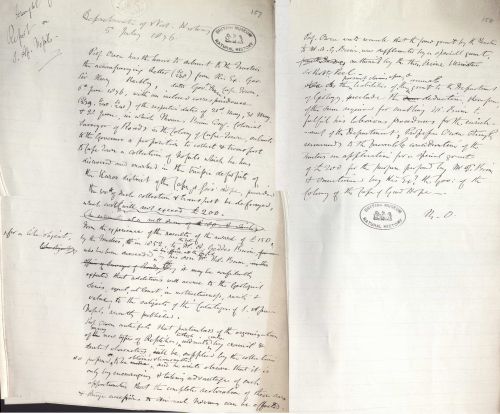 |
|
The draft of the letter sent by Richard Owen to the Trustees of the British Museum on July 5th 1876. This draft letter is in collection of Natural History Museum in London, (Owen Collection 2:157/8). |
Draught of report on S. Afr. Fossils.
Department of Nat. History 5 July 1876
Professor Owen has the honor to submit to the Trustees
the accompanying letter (Ss238) from His Excellencies Governour
Sir Henry Barkly, dated Government House, Cape Town,
6th June 1896, with an enclosed correspondence
(Ss239, Ss240, Ss241) of the respective dates of 21st May,
31st May & 23rd June, in which Thomas Bain Esq. Colonial
Surveyor of Roads in the Colony of Cape Town, submits
to the Govenor a proposition to collect & transport
to Cape Town a collection of fossils which he has
discovered and marked in the Triassic deposits of
the Karoo district of the Cape of Good Hope, provided
the cost of such collection & transport be defrayed,
which will not exceed £200 [3] .
From the experience of the results of the award of £150,
by the Trustees in 1852, to the late Mr. Andrew Gedder Bain,
who has been succeeded in his office at the Cape by his son Mr. Thomas Bain,
it may be confidently expected that additions will accrue to the Geological
Survey, equal at least in [????], rarity &
value to the subjects of the "Catalogue of South Africa
Fossils" recently published.
Professor Owen anticipates that particulars of the organisations
of many new types of Reptilian hitherto [???] only by cranial &
dental characters, will be will be supplied by the collections
so proposal to be obtained & [???] aurmitted and he wants [???]
observe that it is only by encouraging & taking advantage of such
opportunities that the complete restoration of these rare
& strange [????] to animal [???] can be effected.
Professor Owen would remark that the former grant by the Trustees to Mr. A. G. Bain,
was supplemented by a special grant authorised by the Prime Minister Sir Robert Peel.
[???] thus the present claims upon, & liabilities of, the unusual grant to the
Department of Geology, [???] preclude the deduction therefrom
of the sum required for enabling Mr. Bain to fulfil his laborious procedures for the
enrichment of the Department. Professor Owen though recommends to the favorable
consideration of the Trustees an application for a special grant of £200 [3] for the
purpose proposed by Mr. T. Bain & His Exc. The Govenor of the Colony of the Cape of Good Hope.
R.O.
After his proposal was accepted by the British Museum, Bain started to organize the expedition. The expedition was delayed by a year, due to a drought.
On 12 November 1877, Bain left Cape Town for the Karoo and his fossil hunt. On 15 February 1878, returning to Cape Town, he immediately wrote to Owen about results of the expedition.
"... I have collected about 280 heads in all, mostly small ones, but I trust,
none the less interesting on that account, as they are generally in better preservation
than the large ones.
I have also taken out the almost entire skeleton belonging to the large
head Sir. H. Barkly wrote to you about, which I discovered about eighteen months ago;
and I have got a quantity of large bones (some very fine specimens) together with
portions of the skulls belonging to them, showing by the teeth their species.
I have also got some very fine vertebrae of large reptiles, and some fossil wood of different kinds to
show what the Karoo beds contained in former ages.
..."

Note:
[1] The currency values of this time were different from their modern usage.
"Pounds, shillings and pence were the basic currency of Britain throughout the period, having a consistent relationship of 12 pence to the shilling and 20 shillings to the pound. Values are generally expressed as £.s.d., or else l.s.d., as in £12 10s. 6d. or twelve pounds, ten shillings and six pence. The pound sign stands for Libra, a pound weight in Latin, the s. is an abbreviation for shilling in English, and the d. stands for denarius or denarii (a Roman coin).
In additional there were guineas, with a value of 21 shillings (this value could change depending on the quality of the coinage in use), marks (13 shillings, 4 pence), nobles (6 shillings, 8 pence), crowns (5 shillings), half crowns (2 shillings, 6 pence); and coins worth 6 pence, 3 pence, 2 pence, halfpence and farthings (one quarter of a penny)."
[2] In the early part of 1892, when it was already obvious that Owen was dying, his family asked C. Davies Sherborn, self-trained bibliographer who worked at the Natural History Museum in London (formerly the British Museum), to advise them on the sale of the remaining items in Owen's library. This was not an easy task as Owen saved much of the record of his life, that contained over 10.000 letters and manuscripts, stored in disordered manner.
Sherborn selected some items that was of interest for the Museum, the rest, including about a hundred of the scientific letters were retained by the grandson of Owen, the Reverend Richard Owen.
Sir Richard Owen's wife died in 1873 and his son committed suicide in 1886. None of the grandchildren followed him into science nor did any have any understanding of his accomplishments.
Many of these letters and manuscripts were sold by him, as he seemed convinced by the consensus of science that Owen's work was of little value and hardly worthy of recall.It seems that the envelopes from Owen's letters were not of interest to the Natural History Museum. Many of these covers ended up in bookstores and the collections of private collectors, including the cover that is the topic of this page.
[3] £180 in 1876 is worth over £23,000 today, £200 in 1876 is worth over £25,000 today. [R6]
[4] In the XIX century, the geological and paleontological sciences were still in their infancy. The Geological Survey of Great Britain was established in 1818.
Geological periods and rock names were very different from the one we use today.
The following rock divisions were proposed by the Italian Geologist Giovanni Arduino and expanded by the German Geologist Abraham Gottlob Werner:
- Primary rocks, corresponding to the most primitive period of the earth's history, since these rocks were laid down first in the earth crust. These rocks were the first precipitated from the ocean before the emergence of land.
- Above these in order of succession were Transition rocks. These rocks include more indurated limestones (well-cemented), dikes, sills, and thick sequences of greywackes that were the first orderly deposits from the ocean. At the time, only a small number of fossils had been described from these rocks.
- This was followed by the Secondary period, with highly stratified rocks, sandstones, limestones, gypsum and many other layers, filled with fossils.
- Finally, the most recent were the generally unconsolidated deposits of gravels, sand and clays, corresponding to the Tertiary period.
The emphasis on this initially universal ocean spawned the term "Neptunism" that became applied to the concept. The name Neptunism was derived from the Roman God Neptune - the God of the Sea.
Essentially Arduino was able to work out the age relationships between different rock units in northern Italy
(and Werner was able to do the same in central and southern Germany).
They both recognized an older set of crystalline rocks that were overlain by younger rocks including various
types of sedimentary rocks using the basic principle of superposition.
Werner's contribution was that he tried to fit all of the Earth History that the Primary to Tertiary rocks into
a world ocean model - which is essentially trying to fit the natural world to Noah's flood in the Bible.
[5] Oural is an old orthography of the Ural Mountains in Russia.
[6] The term "Permian" strata/period was introduced into geology in 1841 by Sir Roderick Impey Murchison, president of the Geological Society of London, after extensive Russian explorations undertaken with Édouard de Verneuil in the vicinity of the Ural Mountains in the years 1840 and 1841.
Murchison, in collaboration with Russian geologists, named the period after the surrounding Russian region and the city of Perm. [R12]
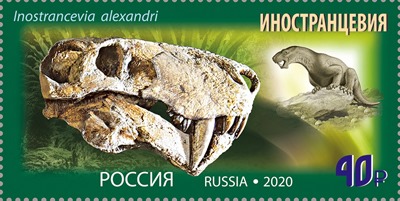 |
| Inostrancevia alexadri on stamp of Russia 2020 MiNr.: 2871, Scott: |
The first discovery of a fossil in the Perm region was reported in 1762, when a trunk of petrified
wood was discovered in one of a copper mines of Tverdyshev.
The first description of animal and plant fossils from the Permian region were
made by Russian zoologist of German origin Stepan Kutorga (1805?-1861) -
"Beitrag zur Kenntniss der Organischen Ueberreste des Kupfersamdsteins am Westlichen Abhange des Urals",
published in German in St. Petersburg, 1838.
References:
- [R1] Sir Richard Owen:
- Wikipedia
- Encyclopedia Britannica
- Fossil Wiki
- Royal College of Surgeons of England
- Strange Science
- NHM in London
- "The rehabilitation of Sir Richard Owen", by Professor Kevin Padian
- "Descriptive and illustrated catalogue of the Fossil Reptilia of South Africa in the collection of the British Museum", by Richard Owen, published in London in 1876 - Google books, digitale-sammlungen.de.
- Correspondence of Richard Owen:
- Richard Owen Commemoration: Three studies. London: Natural History Museum, by Gruber, Jacob W & Thackray, John C (1992)
- digital.library.temple.edu
- amphilsoc.org
- [R2] Henry Barkly:
- [R3] Communication between Sir Richard Owen and Sir Henry Barkly: Geological Society of London.
- [R4] Postal history of Great Britain:
- stampsforsale.co.uk
- warwickandwarwick.com
- The Great Britain Philatelic Society: British Postal Guide, published on October 1st in London (p. 66 - Appendix B - Colonial and Foreign Postage)
- Postmarks and cancellations overview
- The history of the postmarks of the British Isles from 1840 to 1876, compiled chiefly from official records", STANLEY GIBBONS, Inc. 1909 (p. 25, 85).
- [R5] Duplex canceller: Wikipedia
- [R6] Money in Victorian England:
- [R7] Dicynodonts:
Fossil fandom,
Wikipedia,
"Further evidence of the Skeleton of Eurycarpus Oweni" article by Professor H. G. Seeley in 1900,
"A Comprehensive Taxonomic Revision of Dicynodon (Therapsida, Anomodontia) and Its Implications for Dicynodont Phylogeny, Biogeography, and Biostratigraphy", by Christian F. Kammerer and Joerg Froebisch, published in Journal of Vertebrate Paleontology in December 2011 (DOI: 10.1080/02724634.2011.627074) - [R8] Charles Darwin's letters to Richard Owen: Darwin Project
- [R9] Andrew Geddes Bain: Wikipedia
- [R10] Thomas Charles John Bain: Wikipedia
- [R11] Rocks devision in the XIX century:
Abraham GottlobWerner (Wikipedia),
"THE DINOSAUR HUNTERS: A True Story of Scientific Rivalry and the Discovery of the Prehistoric World", by Deborah Cadbury, ISBN-10: 1857029631, published in 2010. - [R12] Permian period: Wikipedia
Acknowledgements:
- Many thanks to Dr. Peter Voice from Department of Geological and Environmental Sciences, Western Michigan University, for reviewing the draft page and his very valuable comments.
- fellow collector Mrs. Jennifer Elizabeth Creagh from Australia.
- fellow collector Dr. Hans Ulrich Bantz from South Africa.
- fellow collector Mrs. Katrin Raynor from UK.
- fellow collector Mrs. Michele Breso from American Topical Association, USA.
- Mr. Mark Samwell B.Sc, B.Arch Managing Director, Samwells Ltd from UK.
- Mr. Andrew Millington Professor Emeritus, Flinders University from Australia.
- Mr. Alan MacGregor and Mr. Hugh Amoore, renowned philatelists from South Africa.
- user daniel on The Stamp forum
- members of Paleophilately, British Commonwealth Stamps & Postal History, American Topical Association groups of Facebook
